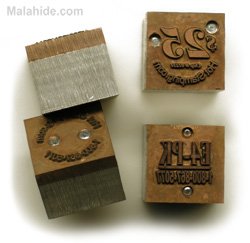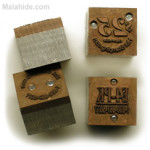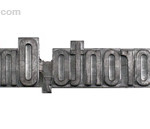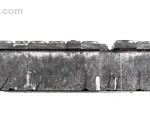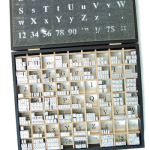About Hot Stamping Dies, Die Plates, Ludlow Line Type and Printer’s Type
Most traditional hot stamp presses employ metal “dies” to produce the image which is transferred onto the product being printed. This page discusses some of the issues and methods of diemaking as they relate to Malahide Hot Stamping Equipment.
DIES
Dies are available in a variety of forms and materials, dies are normally made of metal. Etched upon their surface is the image, graphic or text that is to be hot stamped. The die is held in the hot stamp press by a chase, is heated to 250 ~ 300 F, and then pressed against the foil and the substrate to create the finished hot stamp. Dies can be made of several materials including:
- Magnesium
- Copper
- Lead
- Steel
- Silicone
DIE PLATES
Since Malahide Hot Stamping Presses are high-speed and high-tonnage, we prefer that you use die plates made from magnesium, copper, or steel. Produced by an outside diemaker (don’t try this at home !) a good die will last for tens of thousands of impressions and many years. Die plates cost between $2.00 – $5.00 sq”.
Advantages:
- Easy to handle
- Combine text and graphics in one format
Disadvantages:
- Cost
- Not practical to produce ‘in-house’
MOUNTED DIES
Not all machines and setups use a die plate. The E4-PK for example is most commonly used with a plate that is mounted “type-high” (.918) on a steel, aluminium, or magnesium base.
Advantages:
- Can be printed simultaneously with type
Disadvantages:
- Slightly more expensive
- Figure 9
LUDLOW LINE TYPE
Produced with a ‘Ludlow’ machine, line type is type-high by 3.5″ long. Also known as ‘bonded’ type, Ludlow slugs bear an entire word on one piece (as opposed to printer’s type which produces a word with 1 piece per letter). Produced by casting molten lead into inter-changeable molds, this is the method of choice for type making within the ribbon industry.
Advantages:
- Reusable
- Easy to handle
- Prints evenly
Disadvantages:
- Produces text only
- Lead concerns, handle with care!
- Emits a fume when being cast = proper ventilation required!
- Lulow machines are antiquated and only available second hand
PRINTER’S TYPE
Printer’s Type are small, type-high blocks with a single letter etched upon their surface. A series of type pieces can be grouped together to spell words (i.e.: Malahide would require the assembly of one of: M-A-L-A-H-I-D-E). Since working with many small pieces is time consuming hand work, using type is generally the least preferable method of die making.
Advantages:
- Inexpensive
- Reusable
Disadvantages:
- Time consuming & repetitive in set-up
- Can wear and chip
- Uneven print depths
- Ludlow Line Type
- Ludlow Line Type
- Figure 10
